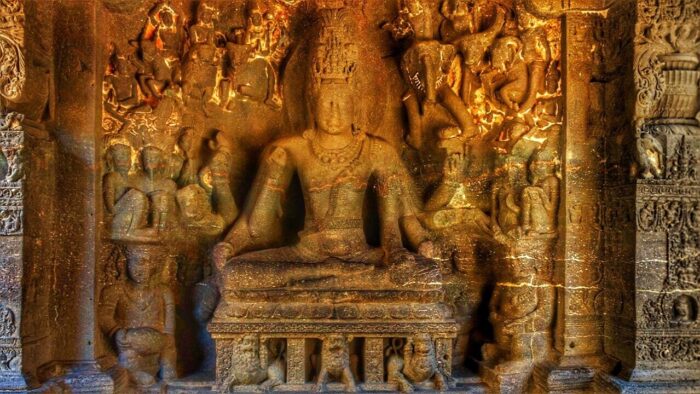The final summit of most traditions of Hindu spirituality is the realization of the absolute identity of Brahman—the Ultimate Reality proclaimed by the rishis as Sat-Cit-Ananda—with Atman, the true individual Self behind our false body-mind identifications. Sat is the eternal verity of existential being, the quintessence of which is Cit—non-dual primal consciousness. While Cit is invisible and ineffable, formless and beyond the reach of the senses and the mind, it is yet the fundamental plenum of intelligence and energy in which all the manifest worlds unfold, and as the rishis assert, it can be known on its own terms. Due to its boundless and ever-fulfilled status, Cit is suffused with Ananda—the sheer, innate bliss of existence which has no cause. If Ananda may be further qualified, it is the wellspring and composite of what we experience in moments of all-encompassing joy, all-embracing love and all-surpassing peace. BrahmAatma Vidya, this real-I-zed knowledge of the blissful identity of the Atman (our Self) with Brahman, is the constant drumbeat and refrain of the Upanishads, Brahmasutras and the Bhagavat Gita, the foundational triad of Advaita Vedanta philosophy (spirituality in theory) and sadhana (spirituality in practice).
Is it not astonishing that the English word realize, if rendered as real-I-ze, may be seen as meaning the discovery of the real I, which is the supreme goal of Vedanta?! If we take the dangling ze and make the Japanese zen out of it, then we have a pointer to the awakening via Zen practices to the same ineffable noumenon. And when we remember that Zen itself is derived from the Sanskrit dhyana, we have a happy congruence in one expanded word of the crux of spirituality in three languages. To real-I-ze is indeed the final goal of all spiritual practice: Self-Knowledge. Even if the word is not thus hyphenated, this connotation is good to keep in mind.
In almost all Hindu scriptures, from the venerable Vedas to the voluminous Puranas, and from there to the vast corpus of Itihasas and Agamas and Tantras and other sastras, the core theme of Brahmanas the Ultimate Reality, and its realization in this very life as the Highest Knowledge to be gained, is inevitably and invariably brought in sooner or later. No matter if the context be a puja at home or a yajna in a temple, a simple private prayer or some elaborate public worship, chanting of mantras or slokas or dancing to divine songs, or any of the other various religious and cultural practices focused on various deities that Hindus follow to this day, some reference to Atman or Brahman directly, or to the major and minor gods and goddesses as being fronts and figure-heads, powers and energies of the primordial Consciousness that is their ground for creation and evolution, is never too far away, be it in the text in print or in the process of live practice.
The last capitalized three words in the previous statement lead us to the grand summary equation of Advaita spirituality: Atma = Brahman = (non-dual) Consciousness. A=B=C says it all and may be called the equation mantra of Advaita, in which is enfolded the alpha and omega of spiritual knowledge. Understanding this equation cognitively is the first step of spiritual evolution; if we then follow up with the body-mind discipline and training that is needed for spiritual sadhana into the mantra aspect, we make progress in delving into the heart of the mystery and are led to the point of Self real-I-zation.
Note that this equation is purely non-denominational: the Atma or Self is the same immortal core of all beings of all faiths and races and genders, whether it be called soul or spirit or something else; Brahman as the primordial Consciousness is fundamentally secular and universally all-pervasive; and no mention is made here of gods and such, though they are all subsumed in that boundless ground. So our equation mantra, both cognitively as an equation and spiritually as a mantra for real-I-zation, is not limited to those of Hindu or Indian persuasion alone. It applies to all sentient beings who are waking up to this inner knowledge of who they are.
Since the realization of Brahman does not entail the triad of the meditator, meditation and what is meditated upon, it is not strictly speaking a meditative experience, though various forms of meditation can get us to the portal to that transcendental awakening. Rather, BrahmAatma real-I-zation is a unitary immersion in the noumenon of the Self, which is revealed in that state as pure consciousness without any subject-object duality, akin to a water-drop losing all sense of separateness when it realizes its oneness with the immensity of water that is the ocean. It is for this reason perhaps that of the eight limbs of Raja Yoga, the first six are steps or processes of preparation leading to the ability to meditate, i.e. do dhyana (the seventh step), after which comes samadhi, which is not a process but the supreme state of blissful non-dual consciousness itself.
In this light, the final value of meditation techniques can only be to surpass the mind so that the transcendental truth of Brahman can be directly known in a non-dual non-experience. It is a non-experience since there is no mind and no subject-object duality in that state. And yet it is an experience or event of some sort, on which reports can be made after returning to “normal”. We may call such happy events meta-experiences. Deep spiritual “experiences”, and most especially Self Real-I-zation at their summit, are therefore meta-experiences.
If we have cultivated an Advaitic temperament with the guidance of an internal or external guru, and have also practiced various forms of saguna, and perhaps even nirguna, meditation to varying degrees of success towards surpassing the mind, we may be ripe for the most powerful mind-dissolving teachings transmitted to us: declarations in the first-person voice and repetitive assertions about the identity of our Self with Brahman, by Ribhu, the mind-born rishi son of Brahma. The goal of the Ribhu Gita is to establish BrahmAatma bhava, the assured feeling and conviction that your Self indeed is that very Brahman which manifests in and as all these innumerous and multivarious forms that make up the multiverse, including you and me and the rest of us and all else that there is, and yet transcends all these transient cosmic phenomena of the manifest realm. These teachings, if heard or chanted or read, and then imbibed and internalized and abided in, are guaranteed to lead to the rasa or feeling of the innate bliss of the Self and pave the way for the ultimate meta-experience of unitary consciousness.
The way to BrahmAatma Bhava that is imparted in the Ribhu Gita may therefore be called meta-meditation, in contrast with traditional meditations which have some object of dharana or dhyana in mind, be it the breath or a deity or the Sun or space or fire. It is not “normal” meditation in that its method is not of contemplation on some object per se. Rather it asserts from the get-go—repeatedly and with the assurance of a realized sage, with appealing analogies and familiar metaphors, strong negations and stronger affirmations, and often with paradoxical or contradictory statements to boggle and expand the mind—that we are already and indeed that very Brahman that we are seeking. It asks us to confidently assume and constantly remember that identity till its truth is revealed in due course as the very result of abiding deeply in that mantric bhava. All the four mahavakyas from the Upanishads: PrajnanamBrahma, Ayamatma Brahma, Tatvamasi and Aham Brahmosmi, which are enfolded in our A=B=C equation, are actively brought into play directly or indirectly in the verses of the Ribhu Gita. The rishi catapults us with his meta-meditations to the meta-experience of Self-Knowledge.
In the parlance of psychology, the approach of the Ribhu Gita is the practice of assuming something to be true on the basis of a reliable authority, living with the conviction of that assumed knowledge, and then finding it to be indeed true based on one’s own direct and irrefutable experience. In terms of neuroscience, the repeated assured affirmations in so many ways of the same essential truth cannot but cut new channels in the brain to overcome our inborn programming for generations on end that we are puny mortal nothings in the cold expanse of space, soon to be dead bodies of blood and flesh, with no purpose or significance to our having been here at all.
Let us now briefly survey the lineage of the Ribhu Gita before delving into its sublime teachings. It appears in the middle of the Sanskrit epic Sivarahasya Purana, which has some 100,000 verses, and comprises chapters 4 to 47 of Part VI of this scripture. It comprises the exposition on Advaita and the nature of Atman and Brahman by rishi Ribhu to his disciple Nidagha, in the presence of an assembly of sages on the slopes of Mount Kedara in the Himalayas. The text proclaims that sage Ribhu received these teachings directly from Lord Siva, the divine embodiment of Brahman in the form of the supreme spiritual guru.
The Sanskrit original of the Ribhu Gita was translated into Tamil in 1924 verses by Brahmasri Bhikshu Sastrigal (aka Ulaganatha Swamigal) in the 1880s.The Paramachariar of Kanchi has noted that: “The terse Tamil translation is superb and brings out the beauty of the text and its essence in all sublimity. It excels the (Sanskrit) original in many places.” This Tamil translation of the Ribhu Gita seems to have been the most recited text in the presence of Bhagavan Ramana Maharishi, that great sage of recent vintage who constantly and naturally abided in the sahaja samadhi of BrahmAatma bhava. The Maharishi is reported to have said that the reading of the Ribhu Gita “is as good as samadhi itself”! So our text comes with the highest of recommendations.
In this session, we will discover the wondrous power of the direct and immediate meta-meditations that make up this priceless teaching to plunge us into the depths of BrahmAatma bhava. We will follow the English translation, by Dr. H. Ramamoorthy and Nome, of the Tamil text of Ulaganatha Swamigal. Called The Song of Ribhu, it is published by the Society of Abidance in Truth (SAT, Santa Cruz, California) and available from Sri Ramanasramam in Tiruvannamalai. It is not necessary to have a copy of the text for this introductory session.
Feature Image Credits: twitter.com
HinduMeditationTraditions&Techniques
Watch video presentation of the above paper here:
Disclaimer: The opinions expressed in this article belong to the author. Indic Today is neither responsible nor liable for the accuracy, completeness, suitability, or validity of any information in the article.








